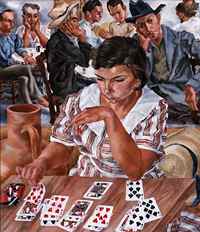
Editor's note: The Tampa Museum of Art provided source material to Resource Library Magazine for the following article or essay. If you have questions or comments regarding the source material, please contact the Tampa Museum of Art directly through either this phone number or web address:
Tales from the Easel: American Narrative Paintings from Southeastern Museums, 1800-1950
April 25 - July 11, 2004

(above: Mary Hoover Aiken, 1907-1992, Café Fortune Teller, 1933, oil on canvas, Telfair Museum of Art, Savannah, Georgia; Gift of friends of Mary Hoover Aiken, 1975)
For generations, American
painters have established a great tradition of engaging narratives. Tales
from the  Easel offers viewers this rich legacy
of storytelling in American art. Paintings by many of this country's most
beloved artists -- Winslow Homer, Thomas Hart Benton, Childe Hassam, Andrew
Wyeth, and others -- show the ever-popular tradition of storytelling through
paintings in America. The stories told in these works illustrate the uniquely
American experience: from the history of our nation's founding to the diverse
experiences of being American, defined by geography, cultural backgrounds
and belief systems. The exhibition showcases seventy wonderful examples
of these masterpieces from twenty-eight different southeastern museums.
(left: George Caleb Bingham, 1811-1879, Washington Crossing
the Delaware, 1856-71, oil on canvas, Chrysler Museum of Art, Norfolk,
Virginia; Gift of Walter P. Chrysler, Jr., in honor of Walter P. Chrysler,
Sr.) [1]
Easel offers viewers this rich legacy
of storytelling in American art. Paintings by many of this country's most
beloved artists -- Winslow Homer, Thomas Hart Benton, Childe Hassam, Andrew
Wyeth, and others -- show the ever-popular tradition of storytelling through
paintings in America. The stories told in these works illustrate the uniquely
American experience: from the history of our nation's founding to the diverse
experiences of being American, defined by geography, cultural backgrounds
and belief systems. The exhibition showcases seventy wonderful examples
of these masterpieces from twenty-eight different southeastern museums.
(left: George Caleb Bingham, 1811-1879, Washington Crossing
the Delaware, 1856-71, oil on canvas, Chrysler Museum of Art, Norfolk,
Virginia; Gift of Walter P. Chrysler, Jr., in honor of Walter P. Chrysler,
Sr.) [1]
Grouped by various themes, the exhibition will explore specific narratives shared by a diverse selection of artwork. For example, one section dedicated to literature brings together works of art that relate to influential texts in the history of mankind. Examples include Edward Hicks' Peaceable Kingdom [2] and Albert Pinkham Ryder's Childe Harold's Pilgrimage as well as scenes retelling the Tales of the Arabian Nights and the New Testament.
Some paintings have personal histories and private reveries
as shown in works such as Thomas Hart Benton's 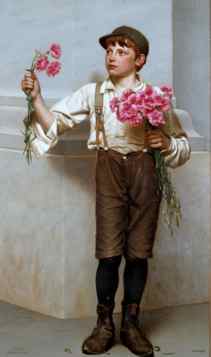 Engineer's Dreams.
It is thought that a love of country music inspired this detailed account
of a train crash and the deeper irony of the great calamities that befall
the badly governed. Painted in 1931, at the height of the Great Depression,
the work is a biting satire of the times. Another section will look at visual
testaments of great American historical moments, including George Caleb
Bingham's Washington Crossing the Delaware and Thomas Hart Benton's
Colonial Brides. A section dedicated to American politics will explore
issues of race, specifically the African-American experience, in poignant
works by Lamar Baker and Gertrude Abercrombie. (right: John George
Brown, 1831-1913, Three for Five, 1890, oil on canvas, Birmingham
Museum of Art, Birmingham, Alabama; Gift of Mr. and Mrs. C.W. Ireland through
the Art Fund, Inc.)
Engineer's Dreams.
It is thought that a love of country music inspired this detailed account
of a train crash and the deeper irony of the great calamities that befall
the badly governed. Painted in 1931, at the height of the Great Depression,
the work is a biting satire of the times. Another section will look at visual
testaments of great American historical moments, including George Caleb
Bingham's Washington Crossing the Delaware and Thomas Hart Benton's
Colonial Brides. A section dedicated to American politics will explore
issues of race, specifically the African-American experience, in poignant
works by Lamar Baker and Gertrude Abercrombie. (right: John George
Brown, 1831-1913, Three for Five, 1890, oil on canvas, Birmingham
Museum of Art, Birmingham, Alabama; Gift of Mr. and Mrs. C.W. Ireland through
the Art Fund, Inc.)
Rural scenes praising the virtues of country life by artists like Jacob Lawrence will be juxtaposed with the harsher realities of urban life from the canvases of George Luks, William Glackens and others. Luks and Glackens were part of the famous Ashcan school of artists, who emerged at the turn of the twentieth century and were particularly interested in showing the underbelly of city life. Other paintings will demonstrate the communities that arose from both the rural and urban experiences, whether they are the crowded Long Island beach scenes as envisioned by Reginald Marsh, or vignettes of American life, including church-going, school life, parades and cafes.
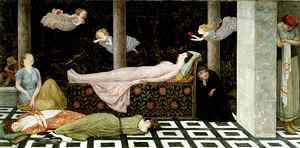 Another
area of the exhibition will look at scenes from domestic life, from interior
scenes showing family activities to works relating to love and animals,
as seen in Winslow Homer's Rab and the Girls. Originally entitled
Over the Hill, this painting is believed to be a subtle reference
to the eligibility of the young women who are his subjects. [3] Standing amidst a field of clover, the
artist alludes to the element of luck (the clover) upon which much domestic
happiness relies. (left: Bryson Burroughs, 1869-1934, Sleeping
Beauty in the Wood, 1917, oil on canvas, Collection of Lauren Rogers
Museum of Art, Laurel, Mississippi)
Another
area of the exhibition will look at scenes from domestic life, from interior
scenes showing family activities to works relating to love and animals,
as seen in Winslow Homer's Rab and the Girls. Originally entitled
Over the Hill, this painting is believed to be a subtle reference
to the eligibility of the young women who are his subjects. [3] Standing amidst a field of clover, the
artist alludes to the element of luck (the clover) upon which much domestic
happiness relies. (left: Bryson Burroughs, 1869-1934, Sleeping
Beauty in the Wood, 1917, oil on canvas, Collection of Lauren Rogers
Museum of Art, Laurel, Mississippi)
Accounts of youth, both humorous and somber, join together
in a look at childhood. From Thomas Sully's 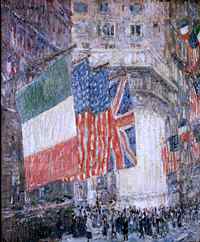 wry Juvenile Ambition to Andrew Wyeth's
haunting Winter, [4] the
assembled works of this section speak of the hope and sometimes despair
which characterize growing up in America. (right: Childe Hassam,
1859-1935, Avenue of the Allies, 1917, oil on canvas, Telfair Museum
of Art, Savannah, Georgia; Bequest of Elizabeth Miller Bullard, 1942) [5]
wry Juvenile Ambition to Andrew Wyeth's
haunting Winter, [4] the
assembled works of this section speak of the hope and sometimes despair
which characterize growing up in America. (right: Childe Hassam,
1859-1935, Avenue of the Allies, 1917, oil on canvas, Telfair Museum
of Art, Savannah, Georgia; Bequest of Elizabeth Miller Bullard, 1942) [5]
Lastly, the exhibition will look at representations of death, notably funeral rituals, in a number of touching works dating from the nineteenth century to Dorothea Tanning's 1946 painting called Guardian Angels. Touching posthumous portraits, imaginary fantasies of lost loved ones, and works showing the diverse death rites of other cultures, tell the story of the profoundly human experience which unites us not only as countrymen but also as human beings. The works in this special exhibition are from twenty-eight prestigious museums throughout the southeast including the Virginia Museum of Fine Arts (Richmond, VA), New Orleans Museum of Art, Speed Art Museum (Louisville, KY), and the High Museum of Art (Atlanta, GA). The exhibition is organized by the Southeastern Art Museum Directors Consortium and also will be exhibited through April 11, 2004, at the Columbus Museum (Columbus, GA) [5] and the Speed Art Museum from September 14 through December 12, 2004.
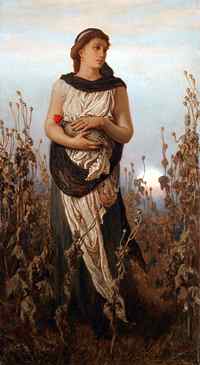 The fully-illustrated
catalogue which accompanies the exhibition, with essays by the exhibition
curators, William C. Eldredge and William Underwood Eiland, will be available
for purchase in the Guilders Museum Store. (left: Elihu Vedder, 1836-1923,
Memory (Girl with Poppies), 1877, oil on canvas, High Museum of Art,
Atlanta, Georgia; Gift of Julie and Arthur Montgomery, 1980.59)
The fully-illustrated
catalogue which accompanies the exhibition, with essays by the exhibition
curators, William C. Eldredge and William Underwood Eiland, will be available
for purchase in the Guilders Museum Store. (left: Elihu Vedder, 1836-1923,
Memory (Girl with Poppies), 1877, oil on canvas, High Museum of Art,
Atlanta, Georgia; Gift of Julie and Arthur Montgomery, 1980.59)
Editor's notes:
[1] Another painting concerning this subject is Emanuel Gottlieb Leutze's George Washington Crossing the Delaware (1851) housed in The Metropolitan Museum of Art. See the americanrevolution.org page on the Leutze painting.
[2] see these RLM articles concerning Edward Hicks:
[3] see Dr. Sarah Burns' essay on this painting reprinted in Resource Library Magazine.
[4] See the North Carolina Museum of Art's website for more information on Winter.
[5] see text and an image of another Avenue of the Allies painting dated 1918 in the Los Angeles Museum of Art website.
[6] RLM readers may also enjoy this earlier article:
Read more articles and essays concerning this institutional source by visiting the sub-index page for the Tampa Museum of Art in Resource Library Magazine.
Visit the Table of Contents for Resource Library Magazine for thousands of articles and essays on American art, calendars, and much more.
Copyright 2003, 2004 Traditional Fine Arts Organization, Inc., an Arizona nonprofit corporation. All rights reserved.